

|
Soundclip:
|
| See Steve's Hand-Written Solo
Transcription |
|
Steve Khan's solo on: "Our Town"(Sammy Cahn-Jimmy Van Heusen) I suppose that some childhood memories stay with us longer than others. Though I was only 8 yrs. old at the time, 1955 was quite a year for my father, Sammy Cahn, as he had won his first Oscar® for "Three Coins in the Fountain" written with Jule Styne, and during that same year, I recall how excited he was about having the opportunity to write original songs for NBC's Producers' Showcase production of Thornton Wilder's wonderful play, "OUR TOWN." At that time, he had gone into a new writing partnership with the great Jimmy Van Heusen. The musical adaptation of the play would star: Frank Sinatra, Paul Newman and Eva Marie Saint. Looking back on everything, it strikes me as a bit strange that they won an Emmy® for the song "Love and Marriage," which came from the same show. 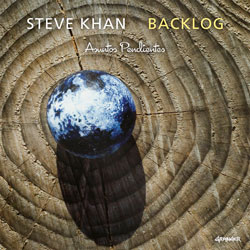 But for me, I always loved the theme song, "Our Town," and found it very moving, as it was given such a beautiful Nelson Riddle arrangement. I have often thought about recording this song, but each time that I considered it, I just could not envision a way to rhythmically interpret it that made sense to me. But, during my preparations for "BACKLOG" an idea suddenly came to me, and after some thought, and a bit of trial and error with my demo-making process, I had a very good feeling about what it could be. But for me, I always loved the theme song, "Our Town," and found it very moving, as it was given such a beautiful Nelson Riddle arrangement. I have often thought about recording this song, but each time that I considered it, I just could not envision a way to rhythmically interpret it that made sense to me. But, during my preparations for "BACKLOG" an idea suddenly came to me, and after some thought, and a bit of trial and error with my demo-making process, I had a very good feeling about what it could be.For my interpretation, I chose to combine two rhythms, the "Afro" beat from Bobby Allende's conga, and the more traditional bolero rhythm supplied by Marc Quiñones' timbal and maracas. Sitting in the middle of those two rhythmic feelings would be drummer Mark Walker's brushes, which would imply a loose sense of a Jazz feeling, while still being related to an overall even 8th-note approach. The final percussive element would come from the bongo, which was overdubbed by Bobby, and offers lots of spice and commentary to what I am playing. Rubén Rodríguez' huge presence on his Baby Bass added great depth, creativity, and feeling in the lower register. No matter what harmonic colors might be added, I always view the texture as a guitar trio with Latin percussion added. In other words, two moving melodic lines: guitar and bass. Like all of the arrangements for this album, I spent a great deal of time on this one. I knew that I wanted to pay homage to some of the touches that Nelson Riddle added to his own arrangement, and I also wanted to add in my own harmonic touches that would reflect my great love for the harmonic style of Clare Fischer. So, the piece begins with the guitar playing a paraphrase of what Nelson Riddle had the french horns playing on the Sinatra version. Though I do not have the most sophisticated library of sounds in my little version of Pro Tools, I have enough to map out an idea of what I want to express. Usually I just do it all with various string pad options. In the end, for a demo, they sound very good, and certainly give anyone listening an idea of what I'm going for. Then, as is often part of my process, I send everything over to the great Rob Mounsey with the rather minimalist hope that he will simply assign better quality sounds to what I have written. He is then armed with the midi tracks, and my own hand-written score sheets. However, this time was to be different, much different!!! As fate would have it, I was the unwitting beneficiary of a time period where Rob just happened to have some free time. And, best of all, I caught his creative spirit and soul at a moment when he would give something most special, both to "Our Town," and to what I had created for "Emily" as well. I don't recall how long it was, after I had brought over the Pro Tools session files and my scores to Rob's home in Brooklyn, but I certainly remember the evening when Rob phoned me to say that he was about send over an mp3 of what he had done with "Our Town." With great humility he told me that, if I felt that he had gone "too far" it was no problem, and he could remove some of what he had done. 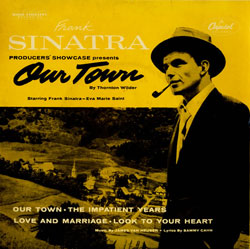 The mp3 arrived, and I sat down in front of my modest computer stereo system, not really to be used for critical listening, but functional, and I pressed "play." At that point in time, the melody was only being played by a little scratch Rhodes track that I had performed myself. Still, as I listened, and sang my father's lyrics to myself, tears came to my eyes, and I just could not believe what I was hearing. I truly felt like the luckiest guy in the world. What had I done to deserve these incredible musical touches that Rob had added to my arrangement? Those touches went way beyond the little things that we had discussed when we met. Each time I listen to this performance, it is still an emotional journey for me. It remains as something far more beautiful that anything that I could have imagined. The mp3 arrived, and I sat down in front of my modest computer stereo system, not really to be used for critical listening, but functional, and I pressed "play." At that point in time, the melody was only being played by a little scratch Rhodes track that I had performed myself. Still, as I listened, and sang my father's lyrics to myself, tears came to my eyes, and I just could not believe what I was hearing. I truly felt like the luckiest guy in the world. What had I done to deserve these incredible musical touches that Rob had added to my arrangement? Those touches went way beyond the little things that we had discussed when we met. Each time I listen to this performance, it is still an emotional journey for me. It remains as something far more beautiful that anything that I could have imagined.Knowing this song, especially the lyrics, as well as I do, I sought to interpret it in a very simple yet expressive manner. As it turned out, the guitar sound on this track is especially gorgeous to me, and James Farber did a beautiful job in capturing what I heard. This is one of those tracks where I can really hear the guitar pumping the speakers in my two Marshall 2x12" speaker cabinets. Sometimes, with a big, warm sound like this, people can't imagine that I am actually playing really LOUD. But, that is exactly what I am doing. When you are using the lower register of the instrument at times, and playing chord voicings that can be full sounding and with some punch to them, you need speakers and cabinets that can handle it. I have included the lyrics here, because I know that most people would never be familiar with this particular song. It is hardly considered a standard by anyone in our music. You will like the folks you meet in our town The folks you'll meet on any street in our town Pick out any cottage, white or brown They're all so appealing, with that lived-in feelin' [A2] You will like the shady lanes in our town The music of the passing trains in our town You will lose your heart, I promise you In this our two-by-four town, "Welcome" on the door town, If you'll make it your town, too. The actual solo section is prefaced by a 6 bar Ensemble section, which I labeled as letter [B], whose first 2 bars are a reharmonization of the principal melody in 6ths. Then, I improvised over the last 4 bars. The rhythmic grouping of the phrase that you see in the 1st bar of the transcription is one that, with some variation, informs the entire solo, especially at the beginning. I'm speaking specifically of the grouping of 2 16th-notes to a half-note in this case. As the solo begins at letter [C], and Rob Mounsey's cascading harp glissando fades away, the first 4 bars emphasize the melodic movement from D-natural over the Ebmaj7 chord to Db over the Db/Eb chord, or a Bbm7/Eb sonority. These are really the key notes that help to define this chord change in the most simple and direct manner, and when surrounded by other color tones, they speak well over the just arrived transparency of the new, more open texture. The chordal punctuations in bar 4 over the same chord are stylistically indebted to the way that Chick Corea was playing Latin music on Cal Tjader's classic album from 1966, "SOUL BURST"(Verve). 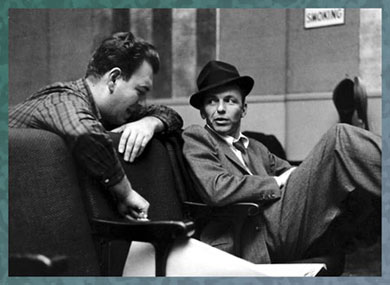 In the end, all such stylings come from, in my opinion, McCoy Tyner, and his playing roughly during the same decade. The cadence of those same chords in bar 5 to Ebmaj7 are chord colors that I love to use, especially when I am in a completely free setting like this. On beat 1, you see/hear a D major triad over Eb which is a sonority that can be viewed in a few different ways. It can feel like it is serving some kind of V7 chord function, because the F#, which could be viewed as the #5 of Bb7, wants to resolve upward to G-natural, the 3rd of Ebmaj7. The D-natural wants to stay where it is, while the A-natural wants to go up 1/2-step to Bb. However, here I did not choose that option, and the staccato D major triad is followed by a C major triad with G-natural on top, that finally resolves to a more consonant voicing in Eb major, spelling up: C(6th)-F(9th)-G(3rd). I really love this kind of delayed resolution. In bar 6, with my line, I am implying that an A7(9b5) chord is being inserted to pull towards the Abmaj7 chord to come. You can view the notes in this line as being derived from either the Eb altered dominant scale [Eb, E, Gb, G, A, B, Db] or E melodic minor [E, F#, G, A, B, C#, D#]. In the end, the notes in both of them are exactly the same. Phrasing-wise, the key ingredient is the little 32nd-note triplet figure, which one might not even notice, but this has been a most important phrasing mannerism, coming from the saxophones, brass, or the piano. It is so important to have these little details as a part of the language of one's playing. In the end, all such stylings come from, in my opinion, McCoy Tyner, and his playing roughly during the same decade. The cadence of those same chords in bar 5 to Ebmaj7 are chord colors that I love to use, especially when I am in a completely free setting like this. On beat 1, you see/hear a D major triad over Eb which is a sonority that can be viewed in a few different ways. It can feel like it is serving some kind of V7 chord function, because the F#, which could be viewed as the #5 of Bb7, wants to resolve upward to G-natural, the 3rd of Ebmaj7. The D-natural wants to stay where it is, while the A-natural wants to go up 1/2-step to Bb. However, here I did not choose that option, and the staccato D major triad is followed by a C major triad with G-natural on top, that finally resolves to a more consonant voicing in Eb major, spelling up: C(6th)-F(9th)-G(3rd). I really love this kind of delayed resolution. In bar 6, with my line, I am implying that an A7(9b5) chord is being inserted to pull towards the Abmaj7 chord to come. You can view the notes in this line as being derived from either the Eb altered dominant scale [Eb, E, Gb, G, A, B, Db] or E melodic minor [E, F#, G, A, B, C#, D#]. In the end, the notes in both of them are exactly the same. Phrasing-wise, the key ingredient is the little 32nd-note triplet figure, which one might not even notice, but this has been a most important phrasing mannerism, coming from the saxophones, brass, or the piano. It is so important to have these little details as a part of the language of one's playing.I decided to treat bars 9-12 of each [C] section differently than they appear during the statement of the melody, because simply going from V7(Bb7) to Imaj(Ebmaj7), one bar each, and then repeating it, is pretty ordinary. So, at the end of bars 10 & 12 each time, I added in an additional ii-V substitution to make it a bit more interesting and challenging: | Bb7(13) / / / | Ebmaj7(9) / / / | Bb7(13) / / / | Ebmaj7(9) / / / | Bars 9-12 - Solo Changes | Bb7(13) / / / | Ebmaj7(9) / Dbm7 Gb7(13) | Fm7(9) / Bb7(13) / | Ebmaj(9) / Gbm7 B7(9) | The addition of these chords not only adds some harmonic interest to the shape of the lines, but it also helps to propel the chord changes back to Fm7 or Bb7. So, during the first [C] section, at bar 5, over the Bb7 chord, you find a chordal punctuation very much in the Tyner style for any dominant 7th chord, a voicing we would associate with a Bb7(13) sonority. This is answered by a line the offers a sense of Fm7(sus). Then, over bar 10, which we have discussed, the line configuration is derived from a chordal shape which, when played in one position sounds great over Ebmaj7, and then, when moved down a 1/2-step, sounds equally great over Dbm7. When bar 12 comes around, the extra turnaround changes are given a different linear treatment, and the target note of G#/Ab over the Gbm7 chord is approached by its chromatic upper and lower neighbors: A and G-natural. But from there, I view the shape of that line as coming from B dominant 7th pentatonic [B, C#, D#, F#, A]. The final 4 bars of this 1st section offer color tones over each of the chord changes. Notice that in bar 13, the line touches upon #9(Db), the 13th(G), and lands on the b9(B-natural). Bar 14 places an emphasis on the 9th(F) of Ebmaj7, and adds in a nice short chordal punctuation on the and-of-3. In bar 15, we have a V7 of V7 with an F7(9b5) sonority. Again, pay attention to the little 32nd note phrasing mannerism in that bar, which sees the line concluding with a B triad(B-F#-D#), which is, of course, the b5 sub for F7. Bar 16 offers another familiar phrasing technique utilizing a triplet pull-off. The line that covers those first 2 beats is really derived from F Dorian [F, G, Ab, Bb, C, D, Eb]. As the Bb7 arrives for beats 3 & 4, you see an ascending E triad(G#-B-E) applied over the chord to give us both the b9 and b5 sounds. Notice how the line resolves from the last B-natural into chordal punctuations that have a C-natural on top!!! To state it again, chords are not just chords, they can be, and should be, extensions of the lines that you play. The top voice of any chord does mean something!!! The chord voicings played as [C2] begins only seem unusual because the top voice is on the B-string, and that is where the single-note line left off. In bar 2 of the section, this linear answer to the chords is derived from the G minor pentatonic [G, Bb, C, D, F], which, as I have indicated in past analyses, supplies most of the pretty color tones: 6th, maj7th & the 9th. Bar 3, over a Bbm7/Eb chord, features a sequence of chordal voicings from the suspended family, as you see Eb's and/or Ab's in almost all of those chords. The answer to these chordal sounds is another line in bar 4, which is derived from the Bb minor pentatonic [Bb, Db, Eb, F, Ab]. Bars 5-9 offer linear configurations that seem to be thematic throughout the solo, and if you view the notes G-C-D over Ebmaj7, and then Ab-Db-Eb over Bbm7/Eb, this should make perfect sense. Also, pay careful attention to the rhythmic groupings, the 16th-note subdivisions, and how they fall right into the bolero groove. The chords that appear in bars 6-7 should remind you of what we saw in bars 4-5 of letter [C]. Here we are traveling from Eb7 to Abmaj7. You see parallel triads: Db-Eb-E, which cadence on a C-F-G-C voicing on beat 1 of the Abmaj7 chord, and this is quickly answered by a C triad leading to that same small voicing of: C-F-G. 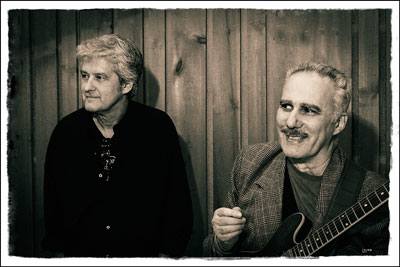 In bar 8, there is a single-note line answer that begins with notes derived from the aforementioned chordal configuration that goes back to lines that we have seen throughout the solo. As part of this line, take note of the little 32nd-note triplet grouping on beat 3. Again, these phrasing devices are essential when you are trying to speak the language of Jazz properly. In bar 8, there is a single-note line answer that begins with notes derived from the aforementioned chordal configuration that goes back to lines that we have seen throughout the solo. As part of this line, take note of the little 32nd-note triplet grouping on beat 3. Again, these phrasing devices are essential when you are trying to speak the language of Jazz properly.The next 12 bars of the section begins what I might refer to as, the emotional payoff to the song. It is interesting that, as the intensity rises, the first 4 bars see the bass line descending. In bar 9 of the section, on beat 2, we see the first bent note with vibrato, and that is followed in the next bar by a line that cadences on the 3rd of Ebmaj2/G with vibrato on that G-natural as well. In bar 11, there is another bent note on the 1st beat, and a line, that is in essence, Eb Dorian [Eb, F, Gb, Ab, Bb, C, Db], tumbles down with some chromaticism to a lower Gb. In bar 12, over the F7 chord, the line simply outlines very basic, but emotional chordal tones. In bar 13 of this part of the overall section, we begin the series of turnarounds: iii-VI7-ii-V7 to iii-bIII7-ii-V7 which repeat. As Gm7 can often be considered as a substitution for Ebmaj7, the line reflects that in feeling with the appearance of the note Eb. Over C7(13b9), the line outlines an A triad: Db/C#(b9)-A(13)-E-Db(b9). Over the Bb7(alt.) chord in the next bar, the line descends through a Bb7(13b9) sonority, with the phrase ending on two 16th-notes, and the phrasing markings above those notes signifies that those notes are to be played long-short, and that small detail is what gives the rest of the band, and the listeners too, where the sense of "swing" comes from - even if this is an even 8th-note rhythmic feeling. This kind of phrasing indication has already happened 11 times during the solo, and I apologize for not having mentioned it sooner, because it is of huge importance! In bar 15, as the chords descend from Gm7 to Gb7, in place of a C7(alt.) chord, the first two beats reflect G Dorian, and over the Gb7 chord, you hear Db Dorian [Db, Eb, Fb, Gb, Ab, Bb, Cb] being put to use. In bar 16, over the Bb7(alt.) chord, you see another usage of an E triad to emphasize the appearances of both the b9(B-natural) and the root(Bb). In bar 17, once again, the sense of Eb major is there, and it is brought home by the high Eb that follows a Bb below. Then again, in the 2nd half of the bar, Db Dorian is the choice over the Gb7 chord, but this time, the line falls to a low Ab. Then, in bar 18, the final ii-V of the section, the 1st 2 beats are F Dorian, and over the Bb7(13b9) chord, you hear a different line configuration that still spells out a G major triad, only with greater emphasis placed upon the b9(B-natural). As Rob's strings subtly re-enter, [C2] closes out with a turnaround that has not, to this point, appeared in the arrangement. It cycles around maj7(9) chords going from: Ebmaj7(9)-Gbmaj7(9)-Bmaj7(9)-Bb7(alt.). The bars are filled with 16th-note subdivisions, as over Ebmaj7, I used G minor pentatonic. Over Gbmaj7, I again use the linear configuration of Db-Gb-Ab derived from a chordal form. Over the Bmaj7 in the following bar, you see D# minor pentatonic [D#, F#, G#, A#, C#] being applied. And the final ascending line over Bb7(alt.) puts to use an angular form of Bb 1/2-tone/whole-tone diminished scale [Bb, B, Db, D, E, F, G, Ab]. Please pay attention to the long-short phrasing markings, as they are so important to how these lines were delivered. As the solo continues with a 1/2-chorus of [C], the section is supported by the rich colors of the strings. Bar 1 offers the last of the chords that I played, and these parallel voicings feature intervals that are from the bottom, a 7th and a 2nd, and this wide spread gives them a unique sound, and a certain punch when played in these rhythms. In the sense, if you look at the top voices of the chords, and the single notes that follow in bar 2, this is a momentary paraphrase from our main melody. Bars 3-4 present a particular kind of Latin feeling that, at a tempo like this one, reminds me of something that the great Eddie Palmieri played behind Cal Tjader on their 1966 version of "Poinciana" at about :51 into the track. This brief, funky moment, is followed by the linear usage of a D major triad over Eb vaulting up to Bb, and a descending line that features the use of the interval of 7ths. 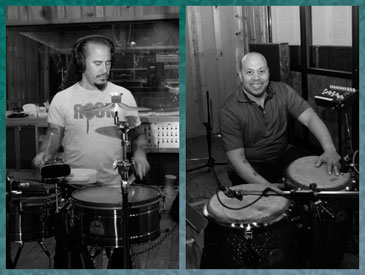 I have always found this to be a rather romantic interval, after hearing British harpist David Snell use them in a particular way behind Zoot Sims' 1966 recording of the very sentimental, "September Song." When the transition to the IVmaj7 chord, Abmaj7, returns, this time, to imply the sense of A7(9b5), the line at the end of bar 6 is derived from E Dorian [E, F#, G, A, B, C#, D], though the note C# is avoided. The 4ths that appear at the end of the line make the coming chord change, before it actually arrives, which is a nice touch. Leading into the consonant line in bar 8, a C triad is played, and that E-natural wants to be resolved to F-natural at some point, and you then find that note in the line in bar 8. As the V7(Bb7)-Imaj(Ebmaj7) passages return for bars 9-12, a small motif appears that carries through this moment, and precedes the arrival of the alternate changes for the 2nd-half of bars 10 and 12. Over the Dbm7-Gb7 chords, the interval of 6ths covers the chord changes, but in bar 12, over the Gbm7-B7, that change is approached by using F# Dorian [F#, G#, A, B, C#, D#, E]. In that same bar 12, I have to point out the appearance of the little 32nd-note phrasing mannerism that has been heard several times during this solo. As the solo draws to a close, in bars 9-10, there is another moment of romance in the phrasing and note choices with one last bent note, a C-natural, over Ebmaj7. The last 2 bars feature a long double-time line that begins over the F7(9b5) chord using C melodic minor [C, D, Eb, F, G, A, B]. As that chord transitions to the final ii(Fm7)-V(Bb7), the line reflects the chromatic usage of F Dorian, as it descends towards a resolution on a G-natural, the 3rd of Ebmaj7, and the main melody returns one last time in a statement of [A2]. I have always found this to be a rather romantic interval, after hearing British harpist David Snell use them in a particular way behind Zoot Sims' 1966 recording of the very sentimental, "September Song." When the transition to the IVmaj7 chord, Abmaj7, returns, this time, to imply the sense of A7(9b5), the line at the end of bar 6 is derived from E Dorian [E, F#, G, A, B, C#, D], though the note C# is avoided. The 4ths that appear at the end of the line make the coming chord change, before it actually arrives, which is a nice touch. Leading into the consonant line in bar 8, a C triad is played, and that E-natural wants to be resolved to F-natural at some point, and you then find that note in the line in bar 8. As the V7(Bb7)-Imaj(Ebmaj7) passages return for bars 9-12, a small motif appears that carries through this moment, and precedes the arrival of the alternate changes for the 2nd-half of bars 10 and 12. Over the Dbm7-Gb7 chords, the interval of 6ths covers the chord changes, but in bar 12, over the Gbm7-B7, that change is approached by using F# Dorian [F#, G#, A, B, C#, D#, E]. In that same bar 12, I have to point out the appearance of the little 32nd-note phrasing mannerism that has been heard several times during this solo. As the solo draws to a close, in bars 9-10, there is another moment of romance in the phrasing and note choices with one last bent note, a C-natural, over Ebmaj7. The last 2 bars feature a long double-time line that begins over the F7(9b5) chord using C melodic minor [C, D, Eb, F, G, A, B]. As that chord transitions to the final ii(Fm7)-V(Bb7), the line reflects the chromatic usage of F Dorian, as it descends towards a resolution on a G-natural, the 3rd of Ebmaj7, and the main melody returns one last time in a statement of [A2].One of the beauties about playing any form of improvised music is that you never quite know what is going to come out at any given moment. Though, like many guitarists of my generation and beyond, Wes Montgomery is always listed as a principal influence, still after all these years, I have really avoided playing octaves anywhere on my recordings. Yes, it has happened for a moment here and there, but I can't even think of those moments right now. However, during the course of playing the melody for "Our Town" there was a moment in bar 13 of [A2] when I just started playing the melody that way, because it felt like the right thing to do, the most musical thing to do. Later, months later, as I was listening during mixing, I realized that during the restatement of [A2], I went into those same octaves two bars earlier. I hadn't even realized that I had done that. 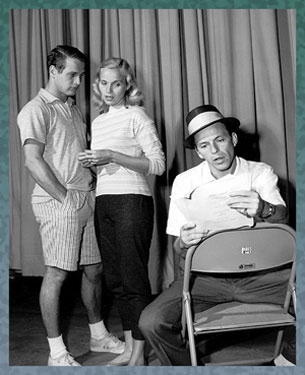 Now, when I listen to those moments, and hear Rob Mounsey's beautiful string arrangement, I am reminded, for an instant, of those great Wes recordings with strings written by Jimmy Jones, Claus Ogerman and Don Sebesky. Neither Rob nor I were thinking of such things when this piece was put together, but, now, there's a feeling about it, for just those brief moments, that makes me think so fondly of Wes, and how he influenced my playing, and my life. I am forever grateful to have been touched by his music. Over the course of this family memory for me, the guiding principal is to just play the melody with simplicity, warmth, and love, and to be in the flow of everything that you hear and feel. That is all that I was trying to accomplish, nothing more. Now, when I listen to those moments, and hear Rob Mounsey's beautiful string arrangement, I am reminded, for an instant, of those great Wes recordings with strings written by Jimmy Jones, Claus Ogerman and Don Sebesky. Neither Rob nor I were thinking of such things when this piece was put together, but, now, there's a feeling about it, for just those brief moments, that makes me think so fondly of Wes, and how he influenced my playing, and my life. I am forever grateful to have been touched by his music. Over the course of this family memory for me, the guiding principal is to just play the melody with simplicity, warmth, and love, and to be in the flow of everything that you hear and feel. That is all that I was trying to accomplish, nothing more.Though intially I did not bother to transcribe what I had played during letter [D], which is the Fade, I have had so many requests from wonderful fans all over the world that I decided to add this transcription to pages here. So, your pleas have been heard!!! This section, where we transition from our Afro-Bolero to a Cha-cha-cha, I will now say a little about it here. There is a tempo that a song has to be at in order for this kind of feel transition to occur and feel right, not forced or contrived. I think that, in this case, we were just at the lower edge of where you can be, tempo-wise, to make it happen. Marc, Bobby, and Mark Walker made it so easy, and seamless. At this transition point, I am simply playing over a mood created by going back and forth between 2 bars of Ebmaj7(9) and 2 bars of Ebm7(sus). That's it, very simple, no more than that, but if done well, it becomes hypnotic, and most evocative. On my original demo for this section, the string pads that I created slowly rise from the middle register, ascending through the roughly 1:35 of this section. Of course, apart from assigning far better sounds to what I had written, as always very much influenced by the voicing style of Clare Fischer, Rob added his own brilliant touches with high string counterpoint that, as the fade and solo goes on, reaches stratospheric heights - they are so beautiful to hear. Another really great touch that ties the whole arrangement together is Rob's wonderful usage of the french horns, which enter at bar 9 of the section, and add their own wondrous slow counterpoint to what I had played. I can't repeat it enough just how much I treasure everything that Rob added to this creation. How lucky could I be? My friendship and musical association with Rob Mounsey now spans some 40 years. It is hard to believe, sitting on this end of the time spectrum, that it has actually been that long. We have contributed to each other's projects, and made two wonderful recordings together as well: "LOCAL COLOR"(1987) and "YOU ARE HERE"(1998). I treasure both of them. Rob's contributions to my recent recordings, beginning in 2005 with "THE GREEN FIELD" have been immense. In the end, I could not have done any of them without his help, guidance, voice of sanity, sense of humor, and supreme musicality. On "BACKLOG," Rob's orchestrations and orchestral touches took on a much great importance than ever before. I have already discussed how Nelson Riddle's original arrangement for Frank Sinatra informed my own arrangement of "Our Town" and now, I feel that this is a great moment to share with you exactly what my own arrangement looked like for strings during most of the piece, and additional colors at [B]. Now I am offering the KEYBOARD LEAD SHEETS here as well. For those of you who might be interested in such things, you can actually see what I wrote out for Rob, and then, while you are listening, you can hear the artistry and sense of great romance that he added, way above and beyond, to make this into a full and rich listening experience. One that I still find exceptionally emotional and moving. For me, as I have stated at these pages on countless occasions, when playing a ballad, especially the melody, I always want to be playing it, expressing it, from the perspective of knowing the lyrics, and hearing them in my imagination, even if only instrumental notes are being played. I always want to be in touch with what the song means to me. As I said when we began, "Our Town" is really a very unknown tune, but for me, it goes back to my childhood, and so, I was around when it was being written, and I probably knew it before Sinatra had even recorded it. Jazz fans often cite John Coltrane's "BALLADS" album as being one of the best examples of playing melodies with great feeling, but with even greater simplicity. Here was one of our music's greatest creative virtuosos, and he simply stated the theme, and that was enough for him. So, how far wrong could the rest of us go if we chose to go down a similar path? To some, this would be blasphemy, or the polar opposite side of Jazz playing, but I have always loved the way Paul Desmond played ballads, and in any context. Where improvising was concerned, there could not have been a more diatonic player than Paul Desmond, but, everything that he played was always so melodic, and deeply connected to the sense of beauty within each song. Again, he played the great standards like he knew the lyrics inside-out. In the end, that is the great lesson here. Standards are so much more than just a melody and some chord changes. There is always a story, and it is so important to learn the lyrics, and to know that story. Doing this will have such a positive effect on the way that you play that song from that moment forward. Addendum: I'm sitting here writing this on Saturday, September 5th, 2020. Ironically, this date is seared in my memory, because it was the wedding anniversary for my father, Sammy Cahn and my mother, now Gloria Franks. In my recollections, this date was treated with great reverence by my father, and there were times when he would get mom some little bauble of affection on the 5th of every month. Of course, a divorce ended all of that. But, here I sit in New York City, in middle of the COVID-19 pandemic, and just two months away from November 3rd, which might well be the most important date or day/night in all of our lives - for the present, and the future. I say this because it will be our one opportunity to vote Donald J. Trump OUT OF OFFICE once and for all, and to begin the long process of restoring some sense of dignity, civility, governmental norms, international norms and countless other important issues - all these things have been under assault and a relentlessly steady process of dismantling since this malevolent and utter fool was elected in 2016. If there comes that moment when we all know that the Joe Biden-Kamala Harris ticket has unseated Trump, 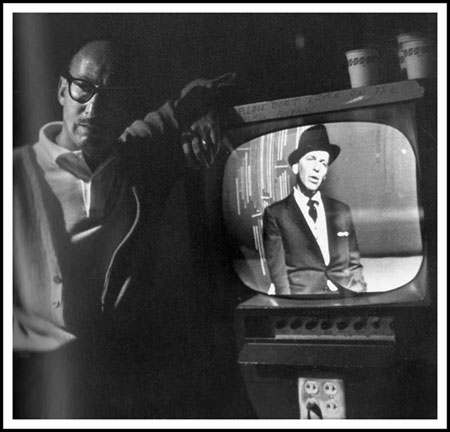 there will be one huge collective sigh of relief coupled, no doubt, with screams of joy and elation across this country and around the world. But now, to the reason that I am drawn to write today. there will be one huge collective sigh of relief coupled, no doubt, with screams of joy and elation across this country and around the world. But now, to the reason that I am drawn to write today.I was thinking about writing a piece for the website on my adventures in vocalese - and I wanted to remember the year in the early '60s when my father went to Brazil for the first time, perhaps, the International Song Festival - but I recall that he was also going to meet a very young composer named Antonio Carlos Jobim - perhaps to discuss WHO might be the person to write the English lyrics to his songs? The first Getz-Gilberto album was recorded in 1963, and I'm certain that this trip to Brazil was BEFORE that historic event. At least that is what I remember. I recall that my father came home with stories, and many LPs from Brazil - I think that I just took all of them - I believe that I still have some of them - but to try to find them would probably not be good for the health of my back, because they are in the one LP cabinet in my music room that is obscured by my stupid couch!!! Anyway, it was on those LPs that I first heard someone singing in vocalese. And it was most unforgettable and stayed with me always - even if unused in the music I began to play and write. My dear sister Laurie remembers Dad telling her about a night in a club listening to a vocalist singing lilting songs, and everyone around him in the audience taking a matchbook and using them to become a kind of group percussion instrument, thus participating in a loving way with the music and the musicians. For some reason, when Laurie shared that memory with me, it reminded me of how James Taylor described his experience in Brazil through the imagery of his very moving song, "Only a Dream in Rio" from 1985. However, in trying to find the year of Sammy's first trip to Brazil, I went to Google and typed in: Sammy Cahn in Brazil, and you will never believe what photo, of great significance to me, came up...... I have never shared the story of the photo of my father, taken at a TV studio with Dad standing next to a TV monitor with Frank Sinatra on the screen. I grew-up seeing THAT PHOTO practically every day of my life, because it was, in the early years, prominently displayed in his office, and later, in his post-divorce home, front and center directly behind his office desk. When he died in 1993, I only asked his estate for two things from the house - just TWO things - they were only of sentimental value to me!!! One was to have THAT PHOTO!!! Of course, through lawyers, I was refused these two requests!!! A gesture that I will never, EVER forget, nor forgive!!! Anyway, after some 27 years - and I had long since given-up ever having or even now wanting that actual framed photo, I was really happy to see it, in some form, on the web as part of an innocent Google search. I have no idea how it got there. It looks like it is actually a photo taken of the photo. I put it into Photoshop, and I did my best to retouch it to make look a bit more like the photo that I remembered. I think that, for an amateur, I did a pretty good job!!! And so now, on this day, I am sharing that work and this photo of great importance to me with all of you. I chose this particular page, because of the all important connection of the song "Our Town" to my father and Frank Sinatra. It comes with my affection for all of those who visit these pages, and maybe actually read them and with the hope that each of you are following the guidelines to be able to STAY SAFE and HEALTHY during these most perilous and insane times through which we are all passing. - Steve
[Photo: Nelson Riddle and Frank Sinatra
Photo: Rob Mounsey and Steve with a sepia treatment by Richard Laird Photo Collage: Marc Quiñones and Bobby Allende @ Avatar Studios by Richard Laird] Paul Newman, Eva Marie Saint, and Frank Sinatra 1955 |